You are using an out of date browser. It may not display this or other websites correctly.
You should upgrade or use an alternative browser.
You should upgrade or use an alternative browser.
Zizzle's Brewbot
- Thread starter Zizzle
- Start date

Help Support Australia & New Zealand Homebrewing Forum:
This site may earn a commission from merchant affiliate
links, including eBay, Amazon, and others.
I think the next hop dropper will be a long narrow carousel that is a bit like an old slide projector (the straight ones, not circular). I'm heading towards DC motors as well. Mostly I find both servos and steppers to be either underpowered for this kind of thing, or way to expensive for my obsession to build. :huh:Great link Arnie, I hadn't seen that photo set before. I got some good ideas out of it.
I have seen your hop adder before. Top idea, though I will probably got for a DC motor and some notches in the rotating disk that activate a microswitch. Stepper motors are a PITA.
So your level sensors work on the water conducting when it is in contact with the brass rods?
I got my valves acutating last night. Seems to work well enough.
The level sensors you see do indeed conduct through water and brass rods. When I get around to it, I will have a combo of those type of sensors and hopefully some capacitive ones - yet to be proven to work though.
Well done on the valves. I have too many things to distract me to have gotten mine to work yet.
The 1-wire stuff is very versatile Geoff, so a good way to go. Just a caution about PC intelligence - If you are running Windoze you could experience some nasty crashes from time to timeThat's brilliant Arnie!! I'm slowly getting my stuff together to build something similar. I'll be going the Maxim / Dallas 1-Wire route for the PC Interface and doing all the control and intelligence via PC / Laptop. Already got my USB to 1-Wire interface: http://www.maxim-ic.com/quick_view2.cfm/qv_pk/3834
Question for you:
How do you go about cleaning all that equipment and pipes after your brews done. And emptying the mash tun for that matter.
Geoff.
Anyway, with my new system I'm designing it for the best of both worlds - intelligent microprocessor control, and even more intelligent PC control if the thing happens to be working.
Re the question: The mash tun emptying is a bit like the hinge and tip method, although there is no hinge. I used to scoop the grains out slowly, but tip and dump off the top level seems to work ok.
I clean mostly during the kettle chill into the fermenters. For all those no-chill people, the chill water (heated to a nice 40 or so degrees after the plate chiller) is great for cleaning - mash tun, plumbing, the lot. In my latest config, I've got a tap I can open to allow the chill water from the outlet of the plate chiller flow back into the other plumbing. I simply flush the water through one tap at a time.
I follow Ross's advice on cleaning the plate chiller. I fill the HLT with a bit of this chill water and add napisan. Once the kettle has drained, I use the pump to pump napisan solution back through the plate chiller into a now empty (except for trub and hops etc.) kettle. I finish by using my hot liquor in line to flush the whole line with clean water. I then dry it all.
And the chill water that escapes this cleaning plan gets stored in a grey water tank for the garden
Thanks Bonj.That's some nice work Arnie.
RS232 kind of rules out any modern laptop. Although any still functional 486 (running Linux of course) should be more than capable if you don't need a GUI interface.
You can get USB to serial adaptors for not too much $. I've got one for mine from Rev Ed:
http://www.rev-ed.co.uk/picaxe/
Just look under products and serial / USB.
And Zizzle, thanks for that Linux link re 1-wire. I've bookmarked that for later.
I know what you're saying. I'm a Linux Systems Engineer so there can only be one way to proceed! :lol:
Thanks for the cleaning tips. When I build my new system it is going to be designed for automated cleaning as one of the key requirements. Just tip and dump the mash tun (on a pivot) and then I'll follow something like Zwickle's regime: Hot Caustic through all pipes and vessels, followed by Citric acid, followed by clean water. But how to do it all environmentally and save water? I'm moving to the UK in 8 weeks so shouldn't be a problem there. It rains most of the year!
Thanks for the cleaning tips. When I build my new system it is going to be designed for automated cleaning as one of the key requirements. Just tip and dump the mash tun (on a pivot) and then I'll follow something like Zwickle's regime: Hot Caustic through all pipes and vessels, followed by Citric acid, followed by clean water. But how to do it all environmentally and save water? I'm moving to the UK in 8 weeks so shouldn't be a problem there. It rains most of the year!
The 1-wire stuff is very versatile Geoff, so a good way to go. Just a caution about PC intelligence - If you are running Windoze you could experience some nasty crashes from time to timeYep, that's experience talking. A bit embarrassing to have a gold plated control system and then to lose it when that nasty OS sh!ts itself. Reminds me of the Southpark movie when Bill Gates gets assasinated by the US military when their presentation gets the blue screen of death

Anyway, with my new system I'm designing it for the best of both worlds - intelligent microprocessor control, and even more intelligent PC control if the thing happens to be working.
Re the question: The mash tun emptying is a bit like the hinge and tip method, although there is no hinge. I used to scoop the grains out slowly, but tip and dump off the top level seems to work ok.
I clean mostly during the kettle chill into the fermenters. For all those no-chill people, the chill water (heated to a nice 40 or so degrees after the plate chiller) is great for cleaning - mash tun, plumbing, the lot. In my latest config, I've got a tap I can open to allow the chill water from the outlet of the plate chiller flow back into the other plumbing. I simply flush the water through one tap at a time.
I follow Ross's advice on cleaning the plate chiller. I fill the HLT with a bit of this chill water and add napisan. Once the kettle has drained, I use the pump to pump napisan solution back through the plate chiller into a now empty (except for trub and hops etc.) kettle. I finish by using my hot liquor in line to flush the whole line with clean water. I then dry it all.
And the chill water that escapes this cleaning plan gets stored in a grey water tank for the garden
Zizzle, I will be watching this thread with great interest - love your automation work so far in the other thread.
I've got two working 1-wire LANs into PCs at home. Pretty proud of my work actually. I'm not going to win any Solderer of the Year awards (are they still giving those out?), but they work!
Unfortunately, my attempts at getting RRDTool running on windows properly have been in vain. Similarly, running several linux distros under VMWare in XP meant I couldn't access the COM1/TTYS0 port....grrrr. I've now got three LiveCDs (Gentoo, Debian, Mandriva) and I'll pick one (possibly at random) and install that.
The problem is, the machine all this is running on holds all my Promash/Beersmith recipes, which are in Windows, so I'm buggered again.... God, I'm having a bad day!
Bring on Friday.
And good luck Ziz, sorry for the rant/hijack!!
I've got two working 1-wire LANs into PCs at home. Pretty proud of my work actually. I'm not going to win any Solderer of the Year awards (are they still giving those out?), but they work!
Unfortunately, my attempts at getting RRDTool running on windows properly have been in vain. Similarly, running several linux distros under VMWare in XP meant I couldn't access the COM1/TTYS0 port....grrrr. I've now got three LiveCDs (Gentoo, Debian, Mandriva) and I'll pick one (possibly at random) and install that.
The problem is, the machine all this is running on holds all my Promash/Beersmith recipes, which are in Windows, so I'm buggered again.... God, I'm having a bad day!
Bring on Friday.
And good luck Ziz, sorry for the rant/hijack!!
SJW
As you must brew, so you must drink
- Joined
- 10/3/04
- Messages
- 3,401
- Reaction score
- 211
I thought this was called going to the bottle shop and picking up a slab?The aim is an automated, unattended brew
Zizzle
Well-Known Member
- Joined
- 22/4/06
- Messages
- 1,001
- Reaction score
- 5
The problem is, the machine all this is running on holds all my Promash/Beersmith recipes, which are in Windows, so I'm buggered again.... God, I'm having a bad day!
I've been using linux exclusively since 1997 so I probably have a higher tolerance than most, but I've had most success with Ubuntu recently. Grab a LiveCD and give it a go. Try the digitemp package under linux for reading your DS1820 temps.
There is a windows emulator called wine that will allow you to run Promash/Beersmith under linux.
You also have the option of having both linux and windows installed and choosing which to use at boot time.
There is a new free package called VirtualBox that allows you to run windows under linux. But I haven't tried it yet.
Don't be afraid to start a "linux in brewing" thread, I know there are many geek-boys here.
But yeah the 1-wire bus is pretty neat.
devo
Str8outtaCoburg
I wouldn't be surprised that some of you guys also have one of those breakfast making contraptions like they have in the movies. 
Ducatiboy stu
Well-Known Member
- Joined
- 2/4/05
- Messages
- 14,268
- Reaction score
- 3,832
Just call me Wallace, and call my dog Gromitt.... :super:
Pumpy
Pumpy's Brewery.
- Joined
- 8/11/04
- Messages
- 4,014
- Reaction score
- 7
Hey Zizzle,If I could source them cheaply I would be all for solenoids. I've already got a cheap plastic one for cold mains water in, but I doubt it would stand up to hot water for very long. It also wasn't that cheap. The dual wiper motor + gate valve setup in the photos cost less.
I had to pull my washing machine apart this morning as it was having conniptions on the spin cycle. What caught my eye were a couple of neat little solenoid valves for the hot and cold inlets. So next time you drive past a dead washing machine on the verge, don't just rip the pump out but go for the solenoids as well.
Those solenoids are great for hot and cold liquor in, but useless for other parts in a brewing system. There are two reasons - they rely on high pressure to operate (back pressure from the tap), and the opening is only a pin-hole - the perfect place for a speck of grain matter to find and clog it.Hey Zizzle,
I had to pull my washing machine apart this morning as it was having conniptions on the spin cycle. What caught my eye were a couple of neat little solenoid valves for the hot and cold inlets. So next time you drive past a dead washing machine on the verge, don't just rip the pump out but go for the solenoids as well.
I use two like these, but just for the water that goes in.
cheers, Arnie
Zizzle
Well-Known Member
- Joined
- 22/4/06
- Messages
- 1,001
- Reaction score
- 5
More progress over the weekend.
My source of windscreen wiper motors hadn't come through yet, so I got impatient and decided that the valves on the pump out put had to be driven by the one motor.
So I tried around all the local places to find for a 3-way ball valve. No joy. No one had any or knew anywhere that would.
I decided to have a go at building my own.
I also went to the wreckers to get another windscreen wiper motor. The cheapest they would do was $20 for and ex Skyline rear wiper motor. Cheaper because it was small. Size == price apparently, which doesn't seem to make much sense to me. Surely rareness sets the price. Never mind, I preferred the smaller one.
My plan was to use two ball vavles on a T-piece driven by some brooker rod turned by the wiper motor. The brooker rod would be at 45 degree between the ball valves to actuate them.
A few hours later (here's me winding it through it's range):

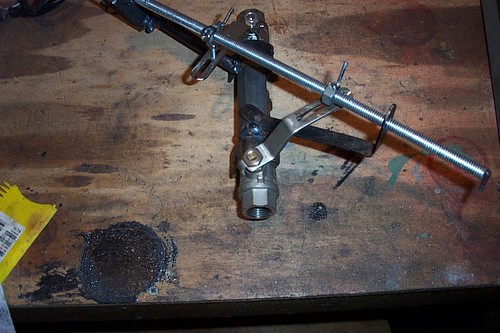
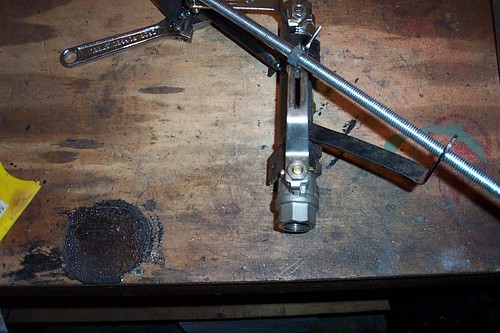
Just as I had it working and was about to mount the wiper motor, I got a call from a mate saying he has found me a 3-way ball valve at his work, and that I could have it. Murphy at work.
So I got to work mounting all my valves & the pump.
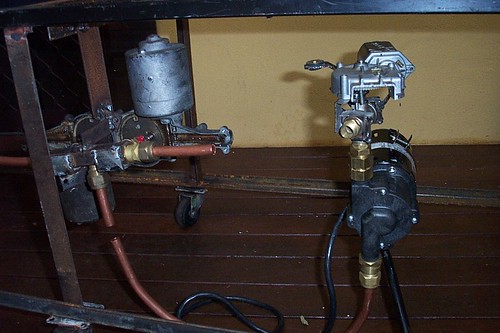
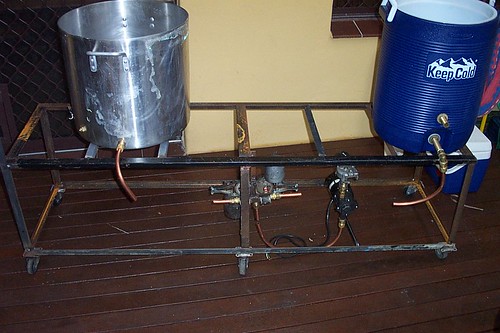
Silicon tubing yet to be put on.
The gap in the pipe on the pump inlet it to allow conductivity to be measured across it. Hopefully the CPU will be able to tell when the line has no fluid in it and shut down the pump.
I also crimped up some stainless dip tube for a set of thermo wells. Here you see it mounted in the HLT.
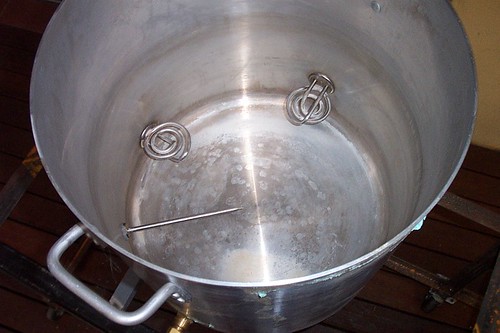
I also trial fitted the brain and console.
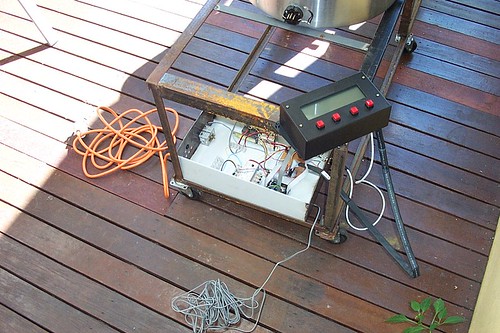
The console will be mounted on a post at about waist height on that corner.
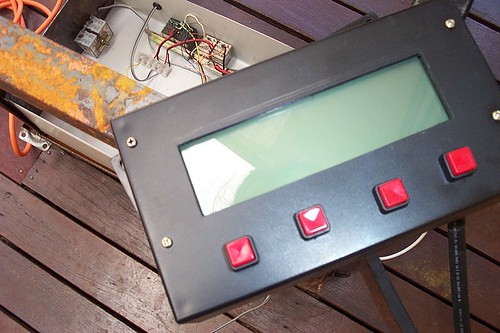
Shocking job lining up that buttons...
My source of windscreen wiper motors hadn't come through yet, so I got impatient and decided that the valves on the pump out put had to be driven by the one motor.
So I tried around all the local places to find for a 3-way ball valve. No joy. No one had any or knew anywhere that would.
I decided to have a go at building my own.
I also went to the wreckers to get another windscreen wiper motor. The cheapest they would do was $20 for and ex Skyline rear wiper motor. Cheaper because it was small. Size == price apparently, which doesn't seem to make much sense to me. Surely rareness sets the price. Never mind, I preferred the smaller one.
My plan was to use two ball vavles on a T-piece driven by some brooker rod turned by the wiper motor. The brooker rod would be at 45 degree between the ball valves to actuate them.
A few hours later (here's me winding it through it's range):



Just as I had it working and was about to mount the wiper motor, I got a call from a mate saying he has found me a 3-way ball valve at his work, and that I could have it. Murphy at work.
So I got to work mounting all my valves & the pump.


Silicon tubing yet to be put on.
The gap in the pipe on the pump inlet it to allow conductivity to be measured across it. Hopefully the CPU will be able to tell when the line has no fluid in it and shut down the pump.
I also crimped up some stainless dip tube for a set of thermo wells. Here you see it mounted in the HLT.

I also trial fitted the brain and console.

The console will be mounted on a post at about waist height on that corner.

Shocking job lining up that buttons...
Jye
Hop Junky
- Joined
- 9/5/05
- Messages
- 3,190
- Reaction score
- 8
Good work on the 3-way valve, Ive been thinking along the same lines and only need one 4-way (1 in and 3 outs) for my setup since I can reverse my pump. Do you have any feed back on the valve to say when it is open or closed? The axle on my wiper motor comes through the other side I was thinking of using a rotary switch attached for the feedback.
... does anyone happen to have a 4-way valve :huh:
... does anyone happen to have a 4-way valve :huh:
Zizzle
Well-Known Member
- Joined
- 22/4/06
- Messages
- 1,001
- Reaction score
- 5
If I had a lathe I would have a shot at making a 4-way valve.
I was wondering how long before someone would ask how the CPU would know when to stop driving the motors on the vavles since it's pretty much impossible to use a micro switch to sense the limits of the gate valves.
With some tricky wiring on the relays I can drive 4 DC motors in forward and reverse using 4 relays. Before the relay pack I have a current sensing/limiting resistor. I can sample using the ADC on the microcontroller the voltage drop across the resistor. The current is proportional to the load on the motor. So as the current across the resistor starts to go up we can tell that the motor has began to be loaded, most likely because it it at the end of it's travel and hitting the stopper on the valve. In that case we cut the power.
You can get tricky in the software too (do the signal condition in sw, add failsafes etc.), but I think that I might just set the value of the resistor so that stalling the motor agaist the stoppers causes no damage.
But I suspect that scheme would not work on a 4-way ball vavle as you don't hit any stoppers on at least one of the ports.
I was wondering how long before someone would ask how the CPU would know when to stop driving the motors on the vavles since it's pretty much impossible to use a micro switch to sense the limits of the gate valves.
With some tricky wiring on the relays I can drive 4 DC motors in forward and reverse using 4 relays. Before the relay pack I have a current sensing/limiting resistor. I can sample using the ADC on the microcontroller the voltage drop across the resistor. The current is proportional to the load on the motor. So as the current across the resistor starts to go up we can tell that the motor has began to be loaded, most likely because it it at the end of it's travel and hitting the stopper on the valve. In that case we cut the power.
You can get tricky in the software too (do the signal condition in sw, add failsafes etc.), but I think that I might just set the value of the resistor so that stalling the motor agaist the stoppers causes no damage.
But I suspect that scheme would not work on a 4-way ball vavle as you don't hit any stoppers on at least one of the ports.
Andyd
Well-Known Member
- Joined
- 30/10/05
- Messages
- 1,092
- Reaction score
- 105
If you really wanted to know where you are for a 4-way ball valve, you'd put a cam on the shaft that flicked a momentary microswitch as the valve handle rotated past registration points.
Zizzle: Any chance you could pop up some schematics for your current sensing driver hardware? I was going to use exactly the same mechanism, but if you've got it working I'd appreciate not having to go through the design/debug stage
Regards,
Andy
Zizzle: Any chance you could pop up some schematics for your current sensing driver hardware? I was going to use exactly the same mechanism, but if you've got it working I'd appreciate not having to go through the design/debug stage
Regards,
Andy
Similar threads
- Replies
- 111
- Views
- 19K



